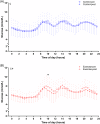Exercise-induced improvement of glycemic fluctuation and its relationship with fat and muscle distribution in type 2 diabetes
- PMID: 38584275
- PMCID: PMC10999499
- DOI: 10.1111/1753-0407.13549
Exercise-induced improvement of glycemic fluctuation and its relationship with fat and muscle distribution in type 2 diabetes
Abstract
Aims: Management of blood glucose fluctuation is essential for diabetes. Exercise is a key therapeutic strategy for diabetes patients, although little is known about determinants of glycemic response to exercise training. We aimed to investigate the effect of combined aerobic and resistance exercise training on blood glucose fluctuation in type 2 diabetes patients and explore the predictors of exercise-induced glycemic response.
Materials and methods: Fifty sedentary diabetes patients were randomly assigned to control or exercise group. Participants in the control group maintained sedentary lifestyle for 2 weeks, and those in the exercise group specifically performed combined exercise training for 1 week. All participants received dietary guidance based on a recommended diet chart. Glycemic fluctuation was measured by flash continuous glucose monitoring. Baseline fat and muscle distribution were accurately quantified through magnetic resonance imaging (MRI).
Results: Combined exercise training decreased SD of sensor glucose (SDSG, exercise-pre vs exercise-post, mean 1.35 vs 1.10 mmol/L, p = .006) and coefficient of variation (CV, mean 20.25 vs 17.20%, p = .027). No significant change was observed in the control group. Stepwise multiple linear regression showed that baseline MRI-quantified fat and muscle distribution, including visceral fat area (β = -0.761, p = .001) and mid-thigh muscle area (β = 0.450, p = .027), were significantly independent predictors of SDSG change in the exercise group, as well as CV change.
Conclusions: Combined exercise training improved blood glucose fluctuation in diabetes patients. Baseline fat and muscle distribution were significant factors that influence glycemic response to exercise, providing new insights into personalized exercise intervention for diabetes.
Keywords: body composition; continuous glucose monitoring; diabetes; exercise; glycemic variability; magnetic resonance imaging.
© 2024 The Authors. Journal of Diabetes published by Ruijin Hospital, Shanghai Jiaotong University School of Medicine and John Wiley & Sons Australia, Ltd.
Conflict of interest statement
All the authors have no conflicts of interest to declare.
Figures



References
Publication types
MeSH terms
Substances
Grants and funding
- SHSMU-ZDCX20212700/Innovative Research Team of High-level Local University in Shanghai
- 20191830/Two Hundred Program from Shanghai Jiao Tong University School of Medicine
- 81870598/General Program of NSFC
- 2022ZZ01002/Shanghai Research Center for Endocrine and Metabolic Diseases
- 82100879/National Natural Science Foundation of China
- 2017ZZ01013/Shanghai Municipal Key Clinical Specialty
- ynts202003/Exploration Fund Grant of Shanghai Sixth People's Hospital
- 2020PJD044/Shanghai Pujiang Program
- 82022012/Excellent Young Scholars of NSFC
- LY01.05.02/Shanghai Key Clinical Specialty Construction Project
- 2022YFA1004804/National Key Research and Development Program of China
- 2018YFA0800402/National Key Research and Development Program of China
LinkOut - more resources
Full Text Sources
Medical

